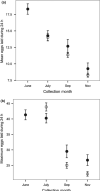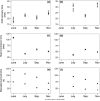Seasonal variation in life history traits in two Drosophila species
- PMID: 26174167
- PMCID: PMC5089932
- DOI: 10.1111/jeb.12690
Seasonal variation in life history traits in two Drosophila species
Abstract
Seasonal environmental heterogeneity is cyclic, persistent and geographically widespread. In species that reproduce multiple times annually, environmental changes across seasonal time may create different selection regimes that may shape the population ecology and life history adaptation in these species. Here, we investigate how two closely related species of Drosophila in a temperate orchard respond to environmental changes across seasonal time. Natural populations of Drosophila melanogaster and Drosophila simulans were sampled at four timepoints from June through November to assess seasonal change in fundamental aspects of population dynamics as well as life history traits. D. melanogaster exhibit pronounced change across seasonal time: early in the season, the population is inferred to be uniformly young and potentially represents the early generation following overwintering survivorship. D. melanogaster isofemale lines derived from the early population and reared in a common garden are characterized by high tolerance to a variety of stressors as well as a fast rate of development in the laboratory environment that declines across seasonal time. In contrast, wild D. simulans populations were inferred to be consistently heterogeneous in age distribution across seasonal collections; only starvation tolerance changed predictably over seasonal time in a parallel manner as in D. melanogaster. These results suggest fundamental differences in population and evolutionary dynamics between these two taxa associated with seasonal heterogeneity in environmental parameters and associated selection pressures.
Keywords: Drosophila; demography; life history; seasonal change.
© 2015 European Society For Evolutionary Biology.
Figures




References
-
- Anderson PR, Oakeshott JG. Parallel geographical patterns of allozyme variation in two sibling Drosophila species. Nature. 1984;308:729–731.
-
- Andolfatto P. Adaptive evolution of non-coding DNA in Drosophila. Nature. 2005;437:1149–1152. - PubMed
-
- Arthur AL, Weeks AR, Sgró CM. Investigating latitudinal clines for life history and stress resistance traits in Drosophila simulans from eastern Australia. J. Evol. Biol. 2008;21:1470–1479. - PubMed
-
- Azevedo RB, James AC, McCabe J, Partridge L. Latitudinal variation of wing: thorax size ratio and wing-aspect ratio in Drosophila melanogaster. Evolution. 1998;52:1353–1362. - PubMed
Publication types
MeSH terms
Associated data
Grants and funding
LinkOut - more resources
Full Text Sources
Other Literature Sources
Molecular Biology Databases

